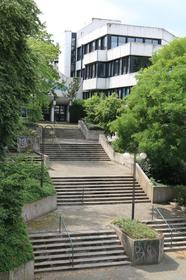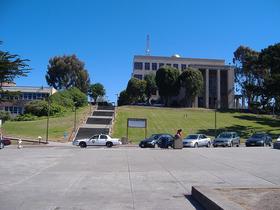- Our mission is to provide access to learning opportunities that promote student success; to foster intellectual growth, individual expression, and character development; and to support a dynamic and diverse environment of innovation and collegiality.
School Highlights
Saddleback College serves 28,742 students (21% of students are full-time).
The college's student-teacher ratio of 36:1 is higher than the state community college average of 32:1.
Minority enrollment is 55% of the student body (majority Hispanic), which is less than the state average of 77%.
Quick Facts (2025-26)
- Enrollment: 28,742 students
- In-state tuition: $1,142
- Out-state tuition: $5,702
- Student-teacher ratio: 36:1
- Minority enrollment: 55%
- Source: Integrated Postsecondary Education Data System (IPEDS)
Top Rankings
Saddleback College ranks among the top 20% of public schools in California for:
School Overview
The teacher population of 805 teachers has stayed relatively flat over five years.
Saddleback College
(CA) Community College Avg.
Carnegie Classification
Associate's Colleges: High Transfer-Mixed Traditional/Nontraditional
Baccalaureate/Associate's Colleges: Associate's Dominant
Institution Level
At least 2 but less than 4 years
At least 2 but less than 4 years
Institution Control
Public
Public
Total Faculty
805 staff
315 staff
School Calendar
Student Body
The student population of Saddleback College has grown by 45% over five years.
The student-teacher ratio of 36:1 has increased from 24:1 over five years.
The Saddleback College diversity score of 0.69 is less than the state average of 0.70. The school's diversity has stayed relatively flat over five years.
Total Enrollment
28,742 students
9,796 students
Student-Teacher Ratio
36:1
32:1
# Full-Time Students
5,957 students
1,259 students
# Part-Time Students
22,785 students
8,537 students
# Enrollment Undergraduate
287 students
242 students
# Full-Time Undergraduate Students
5,957 students
1,250 students
# Full-Time Graduate Students
n/a
63 students
# Part-Time Undergraduate Students
22,785 students
8,299 students
# Part-Time Graduate Students
n/a
10 students
Total Dormitory Capacity
n/a
121 students
% American Indian/Alaskan
n/a
n/a
% Asian
14%
13%
% Hispanic
28%
47%
% Black
2%
7%
% White
45%
23%
% Hawaiian
n/a
1%
% Two or more races
6%
5%
% Non Resident races
1%
1%
% Unknown races
3%
3%
Diversity Score
0.69
0.70
College Completion Rate (Students who graduate in less than 4 years)
46%
42%
College Completion Rate (Students who graduate in 4 years or more than 4 years)
n/a
43%
Average Graduate Earnings (10 Years)
$40,700
$34,700
Tuition and Acceptance Rate
The public in-state tuition of $1,142 is less than the state average of $1,516. The in-state tuition has declined by 14% over four years.
The public out-state tuition of $5,702 is less than the state average of $6,779. The out-state tuition has declined by 39% over four years.
In-State Tuition Fees
$1,142
$1,516
Out-State Tuition Fees
$5,702
$6,779
Tuition Notes
$46 per unit enrollment fee
% Students Receiving Some Financial Aid
43%
85%
Median Debt for Graduates
$9,500
$10,500
Median Debt for Dropouts
$6,500
$6,239
Acceptance Rate
n/a
93%
Source: 2024 (or latest year available) Integrated Postsecondary Education Data System (IPEDS) , School Administrators
School Notes
- We are one of California's top community colleges, known for our well-equipped high-tech learning centers and laboratories, challenging academic curricula, strong student support services, and high transfer rate to universities around the country. Our reputation for excellence continues to attract high quality faculty members and administrators from across the United States. At Saddleback College, students are our top priority. Class sizes here are small and students can expect to receive individual attention from their professors. There is a full range of counseling, career planning and job placement services, financial aid programs, as well as assistance for those with learning disabilities and/or physical limitations. We offer on-campus childcare, a fully staffed Health Center and a variety of tutorial programs. In addition, we have extensive programs and services for re-entry men and women, for older adults through our Emeritus Institute, and for professionals in need of continuing educational credits. We are a premier cultural, entertainment and recreational site in South Orange County. Throughout the year, Saddleback College hosts lectures by news makers and scholars, stages theatre productions and concerts, and screens classic and contemporary foreign films. This upcoming year marks the 29th anniversary of our award-winning Saddleback Civic Light Opera program. Our athletic department proudly boasts 19 intercollegiate teams with a solid reputation for success. In the past 3 decades the Gauchos have earned over 120 conference, state and national titles. The college is accredited by the Accrediting Commission of Community and Junior Colleges, of the Western Association of Schools and Colleges.
Frequently Asked Questions
How much does Saddleback College cost?
Saddleback College's tuition is approximately $1,142 for In-State students and $5,702 for Out-State students.
What is Saddleback College's ranking?
Saddleback College ranks among the top 20% of community college in California for: Least expensive tuition and Largest student body.
Recent Articles

Community Colleges: A to Z – 2025 Guide
Explore the A–Z of community colleges in 2025: programs, affordability, pathways, and innovations for educators and parents.

Community College vs. Dual Enrollment 2025
Compare community college and dual enrollment in 2025. A parent’s guide to affordability, transfer credits, and student success pathways.

Will My Child’s Credits Transfer? Parent’s 2025 Guide
Learn how to ensure your child’s credits transfer in 2025. A parent’s guide to transfer policies, pitfalls, and planning for success.









